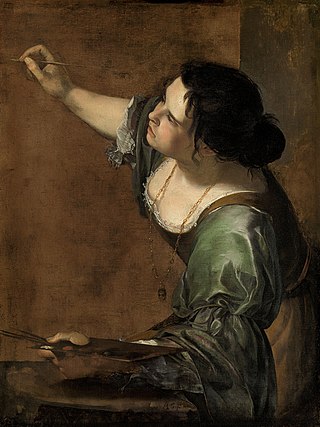
Artemisia Lomi or Artemisia Gentileschi was an Italian Baroque painter. Gentileschi is considered among the most accomplished seventeenth-century artists, initially working in the style of Caravaggio. She was producing professional work by the age of 15. In an era when women had few opportunities to pursue artistic training or work as professional artists, Gentileschi was the first woman to become a member of the Accademia di Arte del Disegno in Florence and she had an international clientele.

Judith Slaying Holofernes is a painting by the Italian early Baroque artist Artemisia Gentileschi, completed in 1612-13 and now at the Museo Capodimonte, Naples, Italy. The picture is considered one of her iconic works. The canvas shows Judith beheading Holofernes. The subject takes an episode from the apocryphal Book of Judith in the Old Testament, which recounts the assassination of the Assyrian general Holofernes by the Israelite heroine Judith. The painting shows the moment when Judith, helped by her maidservant Abra, beheads the general after he has fallen asleep in a drunken stupor. She painted a second version now in the Uffizi, Florence, somewhere between 1613 and 1621.

Susanna and the Elders is a 1610 painting by the Italian Baroque artist Artemisia Gentileschi and is her earliest-known signed and dated work. It currently hangs in the Schloss Weißenstein collection, in Pommersfelden, Germany. The work shows an uncomfortable Susanna with the two men lurking above her while she is in the bath. This was a popular scene to paint during the time of the Baroque period. This subject matter for this painting comes from the deuterocanonical Book of Susanna in the Additions to Daniel. Susanna and the Elders was one of Gentileschi's signature works, with Gentileschi painting a variation of the scene a number of times at the beginning of her career.

Esther Before Ahasuerus is a painting by the 17th-century Italian artist Artemisia Gentileschi. It shows the biblical heroine Esther going before Ahasuerus to beg him to spare her people. The painting is now in the Metropolitan Museum of Art in New York, having been donated to the museum by Elinor Dorrance Ingersoll in 1969. It is one of Gentileschi's lesser known works, but her use of lighting, characterization, and style help in successfully portraying Esther as a biblical heroine as well as the main protagonist of the work.
This is an ongoing bibliography of work related to the Italian baroque painter Artemisia Gentileschi.
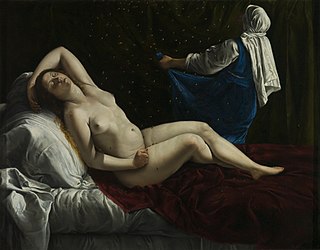
Danaë is a painting by the Italian Baroque artist Artemisia Gentileschi. It hangs in the Saint Louis Art Museum, United States.

Judith and Her Maidservant is one of four paintings by the Italian baroque artist Artemisia Gentileschi that depicts the biblical story of Judith and Holofernes. This particular work, executed in about 1623 to 1625, now hangs in the Detroit Institute of Arts. The narrative is taken from the deuterocanonical Book of Judith, in which Judith seduces and then murders the general Holofernes. This precise moment illustrates the maidservant Abra wrapping the severed head in a bag, moments after the murder, while Judith keeps watch. The other three paintings are now shown in the Museo di Capodimonte in Naples, the Palazzo Pitti in Florence, and the Musée de la Castre in Cannes.

Jael and Sisera is a painting by the Italian Baroque artist Artemisia Gentileschi, executed around 1620.

Self-Portrait as a Female Martyr, is also known as the Self-Portrait as a Martyr Saint. This painting was created by the Italian female artist, Artemisia Gentileschi. This self-portrait was made around 1615 depicting the artist herself as a martyr. It is one of two paintings by Gentileschi painted with oil on a wood panel. This self-portrait is currently in a private collection in the United States.

Santa Cecilia is an early painting by the baroque painter Artemisia Gentileschi, a painter described as "a grand exception in the history of art - a successful woman painter in an era in which art was dominated by men."
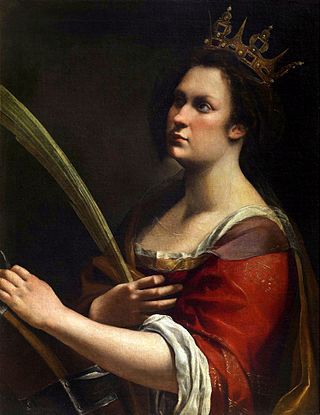
Saint Catherine of Alexandra is a painting by the Italian Baroque artist Artemisia Gentileschi. It is in the collection of the Uffizi, Florence. Gentileschi likely used the same cartoon or preparatory drawing to create both this painting and the Self-Portrait as Saint Catherine of Alexandria (1615–1617), now in the National Gallery, London.

Allegory of Painting is an artwork attributed in 1988 to the Italian baroque artist Artemisia Gentileschi, although more recent research has confirmed it was painted by a Neapolitan anonymous painter in mid-XVIIth century. It hangs in the Musee de Tesse, Le Mans, France.
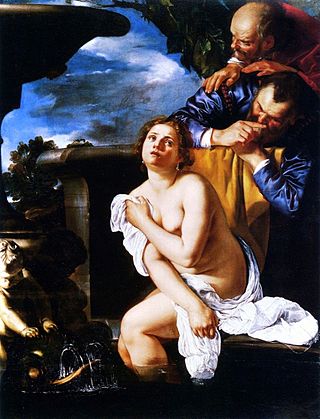
Susanna and the Elders is a painting by the Italian artist Artemisia Gentileschi. It is signed with Gentileschi's name and the date of 1622. The painting is in the collection at Burghley House near Stamford, Lincolnshire, England.
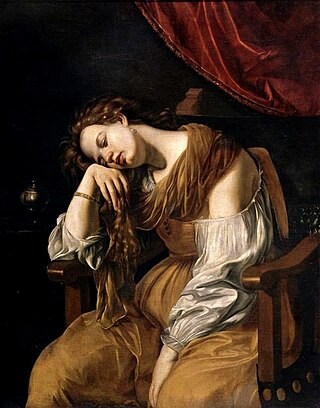
Penitent Magdalene is a painting by the Italian artist Artemisia Gentileschi. It hangs in Seville Cathedral. It has probably been in the cathedral since the late 17th century. She returned to the subject later in the 1620s in Mary Magdalene as Melancholy.
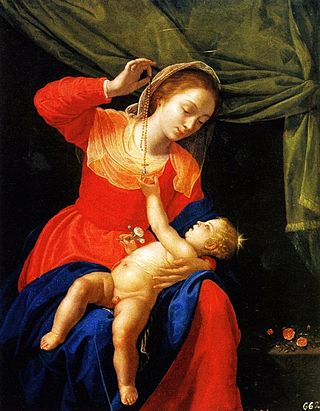
Virgin and Child with a Rosary is one of the last known paintings by the Italian artist Artemisia Gentileschi. Small in size and painted with oil on copper, it was completed in 1651. It was part of the Spanish royal collection and currently hangs in the El Escorial collection, in Spain.

Susanna and the Elders is one of several paintings on this theme executed by the Italian baroque artist Artemisia Gentileschi. This version, painted in 1649, hangs in the Moravská galerie, Brno, Czech Republic. It is signed with Gentileschi's signature, and the date, on the balustrade on the right.

The Self Portrait of Italian baroque artist Artemisia Gentileschi was painted in the early 1630s. It currently hangs in the Palazzo Barberini, Rome. It is one of many paintings where Gentileschi depicts herself. Beyond self-portraits, her allegorical and religious paintings often featured herself in different guises.
Allegory of Inclination is a 1615-1617 oil on canvas painting by Artemisia Gentileschi on the ceiling of the Galleria in the Casa Buonarroti, in Florence. The painting depicts a young nude female seated in the heavens holding a compass. Her light-colored hair is elaborately styled and she is partially covered by swirling drapery. A star appears above her head.

Cleopatra is a 1611-1612 oil on canvas painting of Cleopatra by Artemisia Gentileschi, now in the private Etro collection in Milan.

Bathsheba is a painting by the Baroque painter Artemisia Gentileschi, with contributions by Viviano Codazzi and Domenico Gargiulo. It shows the Hittite woman Bathsheba being washed and tended to by her servants. At the top left of the painting, King David sees her from his palace. It was one of seven versions from the story of Bathsheba that Gentileschi painted.


















